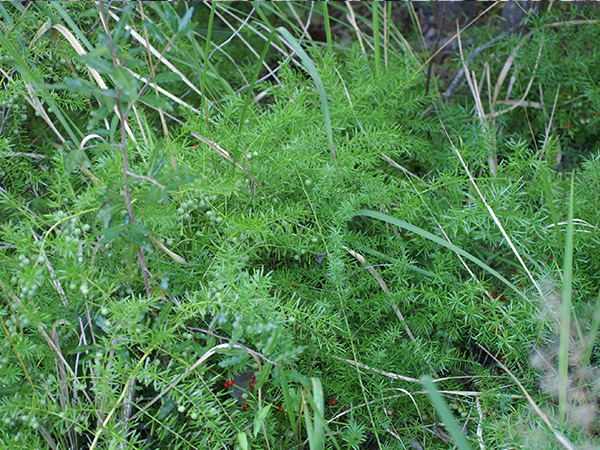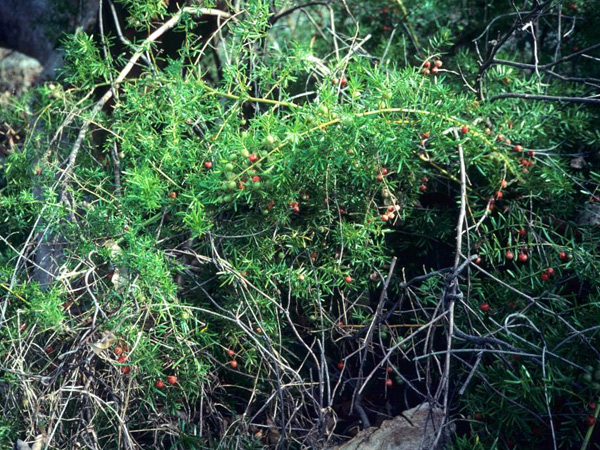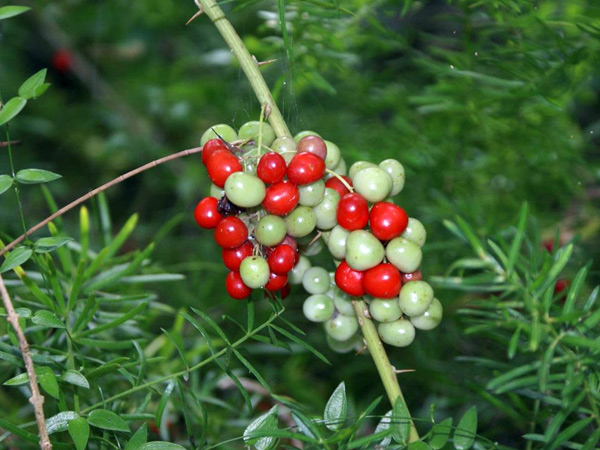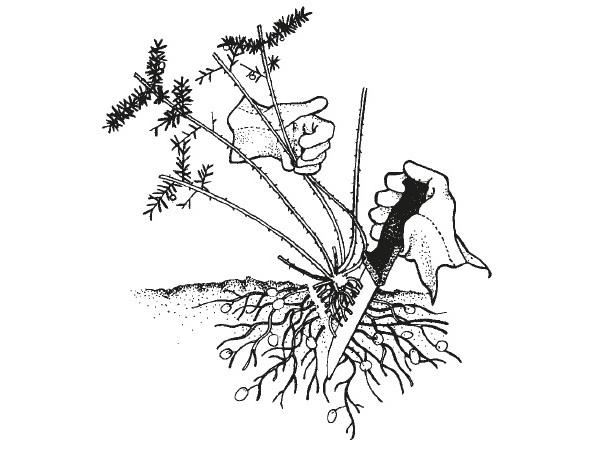Weeds
Ground asparagus – Asparagus aethiopicus
Also known as: asparagus fern, basket fern, Sprengeri’s fern, bush asparagus, emerald asparagus, Sprengeri cultivar, Variegata cultivar.
Ground asparagus is an invasive perennial plant with long prickly stems. It has an extensive root system and is a prolific seeder.
This weed belongs to the group Asparagus weeds
This plant is a Weed of National Significance
This plant must not be sold anywhere in NSW
Profile
How does this weed affect you?
Gound asparagus forms dense blankets of growth above ground and a profusion of roots and tubers below ground which suppresses other ground flora and reduces available soil moisture and nutrients. It is able to tolerate dry periods due to its well developed crowns and numerous tubers. Its is a common garden plant which easily re-establishes after being dumped as garden waste and has become a serious environmental weed.
Where is it found?
Groung asparagus is native to South Africa where it is restricted to the Cape Province and Natal. In New South Wales it is common along the coast from the Queensland border to near Batemans Bay.
How does it spread?
Ground asparagus reproduces both by seed and vegetatively from its crown or corm. Fragments of the short, crown-forming rhizomes can generate new plants, however the roots and tubers themselves cannot reproduce vegetatively, and act only as storage organs.
Spread occurs through the sale of nursery stock to gardeners, the dumping of garden waste containing crowns, fruits and seeds, and when birds feed on the fruit and disperse the seed.
What does it look like?
Ground asparagus is a perennial plant with many arching, persistent stems 1-2 m long arising from a central corm or crown (a compressed group of very short rhizomes that forms a growing point for stems, sitting just below the surface of the soil). The roots are either well-developed and fleshy, bearing numerous, white, watery tubers (roughly ovoid in shape and 1.5 to 3 cm long), or finer and fibrous. The root system forms dense underground clumps and mats.
Stems are hairless, green to brown, often irregularly twisted, with older stems bearing short, straight, stiff spines, 5-10 mm long, just below many of the numerous short, leafy side branches. The “leaves”, which occur in clusters of 1-5, are really cladodes (short, flattened stems that look and function like leaves). They are 1.5 to 2.5 cm long, 0.2 to 0.3 cm wide and taper to a fine short point.
The white-pink flowers, each about 5 mm in diameter, are spaced along a short stem. The fruit is a berry, 5-8 mm wide, green at first then maturing to a glossy red. It contains one or a few black, globular seeds 3-5 mm diameter.
What type of environment does it grow in?
Ground asparagus grows in warm-temperate regions within a temperature range with rainfall from 500 to 1500 mm annually. Preferring sandy or skeletal soils, it occurs in situations ranging from coastal dunes to open woodland, especially where some shade is available.
References
Le Cussan J (2006). Eradication of invasive alien plants on Lord Howe Island, NSW, using three asparagus species (Asparagus asparagoides, A. plumosus, A. aethiopicus) as a case study. Plant Protection Quarterly 21, 117-21.
Parsons WT and Cuthbertson EC (2001). Noxious weeds in Australia 2nd Edn, CSIRO Publishing, Collingwood.
Vivian-Smith G, Gosper CR, Grimshaw T and Armstrong T (2006). Ecology and management of subtropical invasive asparagus (Asparagus africanus Lam. and A. aethiopicus L.). Plant Protection Quarterly 21.
Asparagus Weeds Management Manual (2013), NSW Office of Environment and Hertiage
PittwaterEcowarriers, Asparagus Weed Control 1. Asparagus aethiopicus (ground asparagus), https://www.youtube.com
Personal communication (March 2016), Cat Smykowsky, Bush regenerator, Northern coastal NSW.
Control
The rate and spread of ground asparagus can be minimised by preventing seed formation and contolling plants before flowering begins.
Plants can be controlled by crowning – the practice of digging out the entire crown or corm (by severing the tough surrounding roots – see diagram above) that sits just below the surface of the soil, and leaving the roots and watery tubers in situ. This helps to prevent unnecessary disturbance in sensitive areas, particularly coastal dune environments.
Any small segment of the crown that is left behind can grow a new crown. Bag and burn the crown and any fruiting stems. Carefully spot spray, or recrown any regrowth or seedlings. Care must be taken when applying herbicides to avoid damaging desirable species growing nearby.
Large infestations may require spot spraying, and a penetrant should be used in coastal areas where ground asparagus forms a waxy coating.




